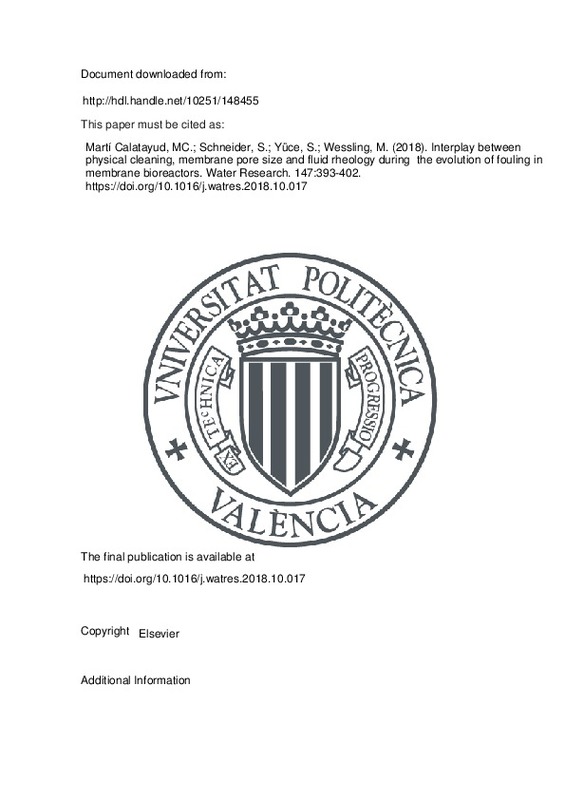JavaScript is disabled for your browser. Some features of this site may not work without it.
Buscar en RiuNet
Listar
Mi cuenta
Estadísticas
Ayuda RiuNet
Admin. UPV
Interplay between physical cleaning, membrane pore size and fluid rheology during the evolution of fouling in membrane bioreactors
Mostrar el registro sencillo del ítem
Ficheros en el ítem
| dc.contributor.author | Martí Calatayud, Manuel César
|
es_ES |
| dc.contributor.author | Schneider, S.
|
es_ES |
| dc.contributor.author | Yüce, S.
|
es_ES |
| dc.contributor.author | Wessling, M.
|
es_ES |
| dc.date.accessioned | 2020-07-22T03:31:30Z | |
| dc.date.available | 2020-07-22T03:31:30Z | |
| dc.date.issued | 2018-12-15 | es_ES |
| dc.identifier.issn | 0043-1354 | es_ES |
| dc.identifier.uri | http://hdl.handle.net/10251/148455 | |
| dc.description.abstract | [EN] Fouling is one of the most pressing limitations during operation of membrane bioreactors, as it increases operating costs and is the cause of short membrane lifespans. Conducting effective physical cleanings is thus essential for keeping membrane operation above viable performance limits. The nature of organic foulants present in the sludge and the membrane properties are among the most influential factors determining fouling development and thus, efficiency of fouling mitigation approaches. The role of other factors like sludge viscosity on fouling is still unclear, given that contradictory effects have been reported in the literature. In the present study we use a new research approach by which the complex interplay between fouling type, levels of permeate flux, membrane material and feed properties is analyzed, and the influence of these factors on critical flux and membrane permeability is evaluated. A variety of systems including activated sludge and model solutions with distinct rheological behavior has been investigated for two membranes differing in pore size distribution. We present a novel method for assessing the efficiency of fouling removal by backwash and compare it with the efficiency achieved by means of relaxation. Results obtained have proven that backwash delays development of critical fouling as compared with relaxation and reduces fouling irreversibility regardless of fluid rheology. It was shown that backwash is especially effective for membranes for which internal fouling is the main cause of loss in permeability. Nonetheless, we found out that for membranes with tight pores, both relaxation and backwash are equally effective. The critical flux decreases significantly for high-viscosity fluids, such as activated sludge. This effect is mainly caused by an intensified concentration polarization at the feed side rather than by internal fouling events. However, membrane permeability has been proven to rely more on the permeate viscosity than on the feed viscosity: poor rejection of organic fractions showcasing high viscosity causes an acute decline in membrane permeability as a consequence of increased shear stress inside the membrane pores. (C) 2018 Elsevier Ltd. All rights reserved. | es_ES |
| dc.description.sponsorship | M.W. acknowledges the support through an Alexander-von-Humboldt Professorship. M.C. Marti-Calatayud acknowledges the support to Generalitat Valenciana through the funding APOSTD2017. M.C. Marti-Calatayud thanks the contributions of Sybille Hanisch, Sanchita Khandelwal and Sara Vivanco. This work was supported by the German Federal Ministry of Education and Research (BMBF) through the project BRAMAR (02WCL1334A). We thank Synder Filtration for the supplied membranes | es_ES |
| dc.language | Inglés | es_ES |
| dc.publisher | Elsevier | es_ES |
| dc.relation.ispartof | Water Research | es_ES |
| dc.rights | Reserva de todos los derechos | es_ES |
| dc.subject | Backwash | es_ES |
| dc.subject | Membrane bioreactors | es_ES |
| dc.subject | Physical cleaning | es_ES |
| dc.subject | Fouling mitigation | es_ES |
| dc.subject | Relaxation | es_ES |
| dc.subject | Sludge rheology | es_ES |
| dc.subject.classification | INGENIERIA QUIMICA | es_ES |
| dc.title | Interplay between physical cleaning, membrane pore size and fluid rheology during the evolution of fouling in membrane bioreactors | es_ES |
| dc.type | Artículo | es_ES |
| dc.identifier.doi | 10.1016/j.watres.2018.10.017 | es_ES |
| dc.relation.projectID | info:eu-repo/grantAgreement/BMBF//02WCL1334A/ | es_ES |
| dc.relation.projectID | info:eu-repo/grantAgreement/GVA//APOSTD%2F2017%2F059/ | es_ES |
| dc.rights.accessRights | Abierto | es_ES |
| dc.contributor.affiliation | Universitat Politècnica de València. Departamento de Ingeniería Química y Nuclear - Departament d'Enginyeria Química i Nuclear | es_ES |
| dc.description.bibliographicCitation | Martí Calatayud, MC.; Schneider, S.; Yüce, S.; Wessling, M. (2018). Interplay between physical cleaning, membrane pore size and fluid rheology during the evolution of fouling in membrane bioreactors. Water Research. 147:393-402. https://doi.org/10.1016/j.watres.2018.10.017 | es_ES |
| dc.description.accrualMethod | S | es_ES |
| dc.relation.publisherversion | https://doi.org/10.1016/j.watres.2018.10.017 | es_ES |
| dc.description.upvformatpinicio | 393 | es_ES |
| dc.description.upvformatpfin | 402 | es_ES |
| dc.type.version | info:eu-repo/semantics/publishedVersion | es_ES |
| dc.description.volume | 147 | es_ES |
| dc.identifier.pmid | 30336342 | es_ES |
| dc.relation.pasarela | S\384663 | es_ES |
| dc.contributor.funder | Generalitat Valenciana | es_ES |
| dc.contributor.funder | Alexander von Humboldt Foundation | es_ES |
| dc.contributor.funder | Bundesministerium für Bildung und Forschung, Alemania | es_ES |







![[Cerrado]](/themes/UPV/images/candado.png)

